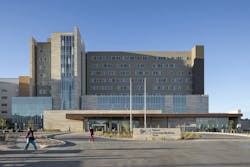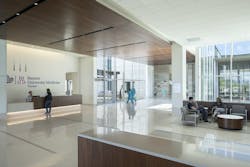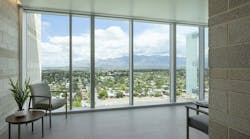Big Room equals big results
The goal of Banner University Medical Center Tucson’s new $320 million Patient Tower and Renovations project was to reinvigorate the aging Academic Medical Center and create a destination for state-of-the-art healthcare in Tucson Arizona.
The project made use of a Big Room approach where the entire project team, including additional engineering consultants and sub-contractors, co-located and worked side by side for four of the five years the project was underway. The Big Room approach helped to optimize project results, reduce waste, and maximize efficiency throughout the design process. The Big Room evolved throughout the project life based on the progression of the project and key players. At any given time, approximately 70 people were in the Big Room.
Big Challenges for the Big Room
One challenge the Big Room helped to overcome was that of the budget. The final budget for the project was $320 million, but the original design estimate was in excess of that number, which required the team to react quickly with cost saving strategies. Teams were responsible for decreasing costs within their area of expertise and a visual graphic of a thermometer helped track the progress in the room. As costs rose, the temperature went up, and as VE solutions were implemented, the temperature cooled.
Team members meeting in a physical location also helped with the project scheduling and quality of such a large project. Co-locating key project stakeholders together in a Big Room allowed team members to literally turn to one another to get answers rather than waiting for emails, phone calls, or navigating team members in different cities or time zones.
Another decision that helped with project scheduling was dividing the project into “rounds.” The idea was inspired by musical rounds, where a composition of different voices singing the same song, but with each voice beginning at different times so different parts of the melody coincide. The rounding schedule divided the building in manageable pieces similar in program, roughly 15,000 to 20,000 sf. Each piece was taken from schematic design all the way through construction documents, when it was handed off to the engineers and trade partners for them to follow suit with coordination.
The rounds incorporated user group sign-off milestones, owner reviews, and Authority Having Jurisdiction (AHJ) reviews. Scheduling the reviews in advance allowed for a faster delivery of the final product because the team could still be working on subsequent rounds while the previous round was under review.
Other Big Room strategies included the Town Hall, the Half-time Show, and the Wall of Fame. The weekly Town Hall meetings were one of the most successful strategies. At the meetings, the teams shared process made throughout each week concluding the three-day work week in the Big Room. Activities during the Town Hall meetings included introducing new team members, designating a different spokesperson each week to report out from each functional team, and a plus/delta assessment to improve on current processes and share successes.
The Half-time Show was an entire day half way through the project that was dedicated to reflection, lessons learned, plans for improvement, milestones, and team building. Whereas The Wall of Fame started as a display of images posted on the wall to capture project activities and fun moments among team members. These opportunities for personal connections helped to create more communication and creative problem solving.
Hospital design that defies stereotypes
One thing the design team wanted to avoid was creating a cold, clinical environment that is often produced due to the stringent requirements of hospital design. As such, Banner University Medical Center’s New Patient Tower and Renovations project is infused with biophilic patterns, maximizes natural light, incorporates circadian rhythms, uses non-toxic materials, and offers patients, visitors, and staff comfort and respite.
Biophilic design patterns are inherent in all major aspects of the project, such as an abundance of natural light and expansive views and the inclusion of gardens with native plantings, shade, ample seating, and walking paths.
In areas where dense programming requirements resulted in limited daylight opportunities, such as in the clinical tower, lighter wood tones and brighter accent colors were used to help maintain a consistent feeling of lightness across the project.
Included in the hospital is furniture that is comfortable and functional, various guest seating options, a large waiting area, a chapel, and a bright cafe designed to support patients, families, caregivers, and the community.
In order to respond to Banner Health’s flexibility goals, planning strategies were developed including ten new interventional labs providing adaptability of assignment between Cath, EP, and imaging procedures; waiting rooms that can be reabsorbed into clinical space; reading/PACS workstations that can be converted into future imaging rooms; and 10,000 sf of shell space that can accommodate a wide range of services in the future.
The project also emphasizes a strong connection to Tucson’s history and landscape. An abundance of natural stone wraps the entry to the building, bridging the gap between the natural environment and the entry pavilion while the Sonoran Desert influenced the colors and patterns used for materials and finish selection. The single-story entry pavilion softens the transition from exterior to interior, leading visitors through the new public amenity spaces to the adjoining bed tower.
The project, which totals 670,000 sf, was completed in 2019.
Submitting Firm, Architect: Shepley Bulfinch
Owner: Banner University Medical Center Tucson
Architect of Record: GLHN Architects & Engineers
Structural Engineer: Martin, White & Griffis
MEP Engineer: AEI Affiliated Engineers Inc.
General Contractor: Sundt | DPR Construction Joint Venture
Size: 670,000 sf
Construction Time: January 2016 to April 2019
Cost: $320,000,000
Delivery Method: CM at Risk with an integrated project delivery approach
Photo credit: Jeremy Bittermann / Joel B Sanders Agency



